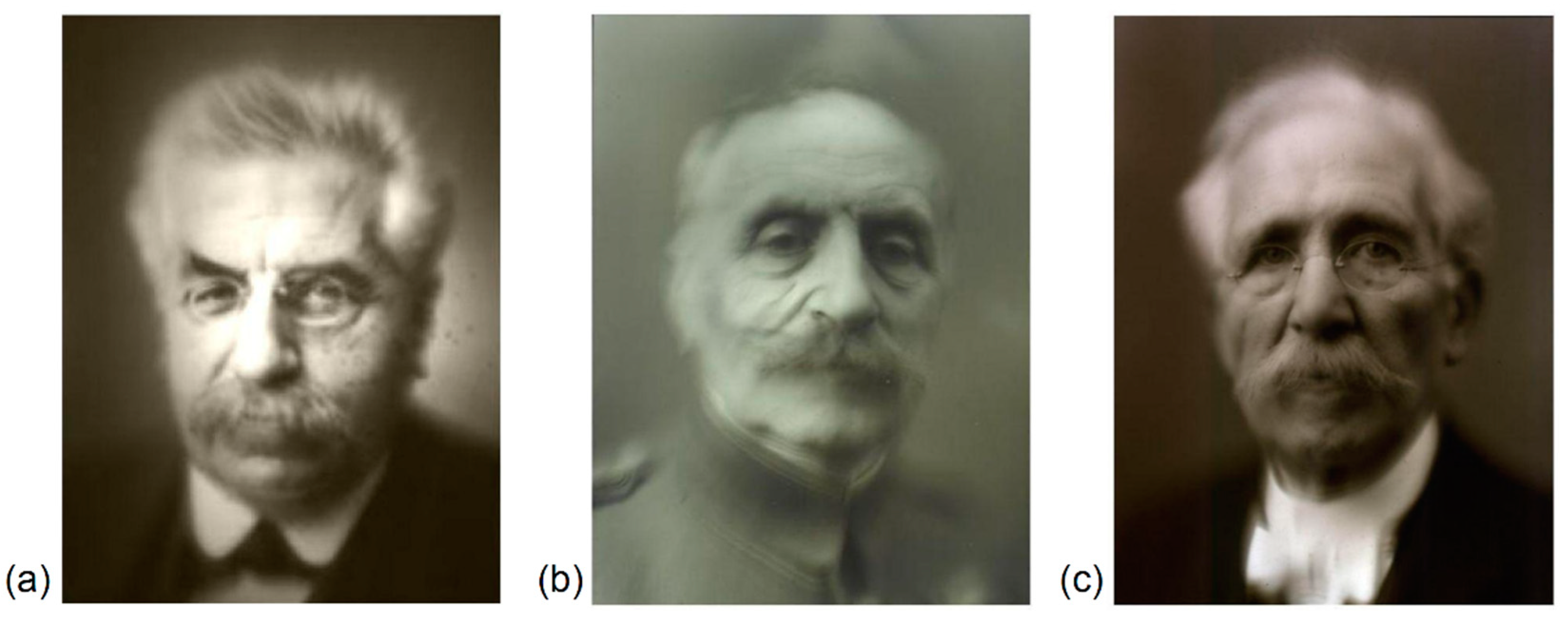Holostereosynthesis: An Improvement to Louis Lumière’s Photostereosynthesis Technique
Abstract
1. Introduction
2. Materials and Methods
2.1. Set of Images
2.2. Plates and Processing
2.3. Recording Digital CHIMERA Holographic Stereograms
2.4. Illumination of Holograms
3. Results
3.1. Reconstruction of a Portrait by Photostereosynthesis
3.2. Holostereosynthesis with CHIMERA Holographic Stereograms
4. Discussion
Supplementary Materials
Author Contributions
Funding
Institutional Review Board Statement
Informed Consent Statement
Data Availability Statement
Conflicts of Interest
References
- Lumière and the invention of cinematography. Nature 1935, 136, 803–804. [CrossRef]
- Wood, J. The Art of Autochromes: The Birth of Color Photography; University Of Iowa Press: Iowa City, IA, USA, 1993. [Google Scholar]
- Lumiere, L. Représentation photographique d’un solide dans l’espace. Photo-stereo-synthèse. SPIE Milest. Ser. Ms 1920, 162, 331–336. [Google Scholar]
- Banks, M.S.; Read, J.C.; Allison, R.S.; Watt, S.J. Stereoscopy and the human visual system. SMPTE Motion Imaging J. 2012, 121, 24–43. [Google Scholar] [CrossRef] [PubMed]
- Mansfield, P. Multi-planar image formation using NMR spin echoes. J. Phys. C Solid State Phys. 1977, 10, L55–L58. [Google Scholar] [CrossRef]
- Evans, B. Practical 3D Printers: The Science and Art of 3D Printing; Apress: New York, NY, USA, 2012. [Google Scholar]
- Wetzstein, G.; Lanman, D.R.; Hirsch, M.W.; Raskar, R. Tensor Displays: Compressive Light Field Synthesis Using Multilayer Displays with Directional Backlighting; MIT: Cambridge, MA, USA, 2012. [Google Scholar]
- Adelson, E.H.; Wang, J.Y.A. Single lens stereo with a plenoptic camera. IEEE Trans. Pattern Anal. Mach. Intell. 1992, 14, 99–106. [Google Scholar] [CrossRef]
- Kim, H.M.; Kim, M.S.; Lee, G.J.; Jang, H.J.; Song, Y.M. Miniaturized 3D Depth Sensing-Based Smartphone Light Field Camera. Sensors 2020, 20, 2129. [Google Scholar] [CrossRef] [PubMed]
- Schröter, J. 3D: History, Theory, and Aesthetics of the Transplane Images; Bloomsbury Publishing: New York, NY, USA, 2014. [Google Scholar]
- Saxby, G.; Zacharovas, S. Practical Holography-Fourth Edition; CRC Press: Boca Raton, FL, USA, 2015. [Google Scholar]
- Richardson, M.J.; VWiltshire, J.D. The Hologram: Principles and Techniques; John Wiley & Sons: Hoboken, NJ, USA, 2017. [Google Scholar]
- Gabor, D. A new microscopic principle. Nature 1948, 161, 777. [Google Scholar] [CrossRef] [PubMed]
- Bloom, P.J. Pre-cinema as paradigm and collection at the Getty Research Institute. Early Popul. Vis. Cult. 2020, 18, 82–92. [Google Scholar] [CrossRef]
- Monteiro, H.G. Media Archaeology as Film Practice—The Werner Nekes Collection. Int. J. Stereo Immersive Media 2021, 5, 58–73. [Google Scholar]
- Gentet, Y.; Gentet, P. Chimera, a new holoprinter technology combining low-power continuous lasers and fast printing. Appl. Opt. 2019, 58, G226–G230. [Google Scholar] [CrossRef] [PubMed]
- Gentet, P.; Gentet, Y.; Lee, S.H. Ultimate 04 the New Reference for Ultra-Realistic Color Holography. In Proceedings of the 2017 International Conference on Emerging Trends & Innovation in ICT (ICEI), Pune, India, 3–5 February 2017; pp. 162–166. [Google Scholar]
- Ultimate Holography. Available online: https://www.ultimate-holography.com (accessed on 31 October 2022).
- Yamaguchi, M.; Koyama, T.; Endoh, H.; Ohyama, N.; Takahashi, S.; Iwata, F. Development of a Prototype Full-Parallax Holoprinter. In Practical Holography IX; International Society for Optics and Photonics: Bellingham, WA, USA, 1995; Volume 2406, pp. 50–56. [Google Scholar]
- Gentet, P.; Gentet, Y.; Lee, S.H. New LED’s Wavelengths Improve Drastically the Quality of Illumination of Pulsed Digital Holograms. In Digital Holography and Three-Dimensional Imaging, M3A-M4; Optical Society of America: Washington, DC, USA, 2017. [Google Scholar]
- Taylor, R.A. Curious conundrum; The state of holographic portraiture in the 21st century. J. Phys. Conf. Ser. 2013, 415, 012004. [Google Scholar] [CrossRef]





Publisher’s Note: MDPI stays neutral with regard to jurisdictional claims in published maps and institutional affiliations. |
© 2022 by the authors. Licensee MDPI, Basel, Switzerland. This article is an open access article distributed under the terms and conditions of the Creative Commons Attribution (CC BY) license (https://creativecommons.org/licenses/by/4.0/).
Share and Cite
Gentet, P.; Gentet, Y.; Lee, S. Holostereosynthesis: An Improvement to Louis Lumière’s Photostereosynthesis Technique. Appl. Sci. 2022, 12, 12524. https://doi.org/10.3390/app122412524
Gentet P, Gentet Y, Lee S. Holostereosynthesis: An Improvement to Louis Lumière’s Photostereosynthesis Technique. Applied Sciences. 2022; 12(24):12524. https://doi.org/10.3390/app122412524
Chicago/Turabian StyleGentet, Philippe, Yves Gentet, and Seunghyun Lee. 2022. "Holostereosynthesis: An Improvement to Louis Lumière’s Photostereosynthesis Technique" Applied Sciences 12, no. 24: 12524. https://doi.org/10.3390/app122412524
APA StyleGentet, P., Gentet, Y., & Lee, S. (2022). Holostereosynthesis: An Improvement to Louis Lumière’s Photostereosynthesis Technique. Applied Sciences, 12(24), 12524. https://doi.org/10.3390/app122412524





